
views
Choosing Quality Stock

Buy bettas from one breeder. If you are buying bettas to breed, make sure to get them only from one specific, reputable breeder. This can help ensure the quality and success rate of your betta spawn. Be aware that getting quality bettas to breed can be expensive. More expensive fish generally mean that a breeder has also used selective breeding techniques. Although this isn't a guarantee of successful breeding, it can ensure the health and quality of your fish and possible their spawn. Some elements to look for in a breeder include: accomplishments, longevity, experience, knowledge, professionalism, affiliation with betta organizations, availability, reputation, track record, cleanliness, reference. Ask the breeder to let you know about the parentage of the bettas. If he can't answer the question, you may want to consider using another breeder that keeps tabs of his bettas' parentage. Find quality betta breeders through organizations such as the International Betta Congress. If you have friends or family that breed bettas or are familiar with them, you might ask them for suggestions, too.
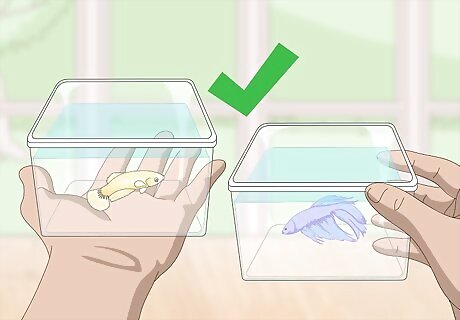
Choose your optimal betta pair. Figure out which bettas to get depending on what qualities you're hoping to highlight or breed out. You want to get the best quality stock you can afford and finding the right pair can help ensure health, beauty, and even your enjoyment. Make sure that you and your breeder both have knowledge of your fish's genetics. Knowing which traits can be inherited is important for responsible breeding to prevent generations of fish that follow from being unhealthy. Be aware that selective breeding is meant to bring out certain characteristics in a betta fish. For example, you may want to bring out black lace patterns in your betta. By choosing another betta with more distinctive lace patterns and mating it with your betta, you can bring out this particularly quality. You can apply this principle to color and fin size, too. Remember that if you're hoping to achieve a certain goal through your selective breeding, either with fin size or color, it can take a few years and cycles for these traits to fully appear. You can either use hybridization or inbreeding for desired traits. Hybridization will bring out the best traits in two genetically different parents, and inbreeding crosses two similar parents for offspring that also have the similar traits.
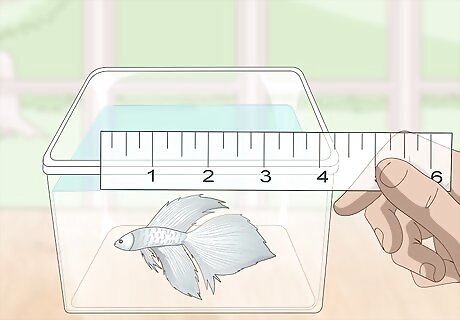
Check the size. Betta breeding can be rough no matter what, but it's important to get fish that are approximately the same size. This helps prevent injury to one of the fish. Looking at the size of each betta can ensure healthy spawn and a healthy breeding process for each fish. Be aware that a fish that is too small may be too young to breed. Aim to breed bettas that are four to twelve months old, which can help ensure that the sizes are proportionate as well as help prevent bad quality spawn. Detect sexual maturity in your betta by looking for males that build bubble nests and females that have a whitish egg spot on their underside. Females are also able to build bubble nests - don't let that fool you.
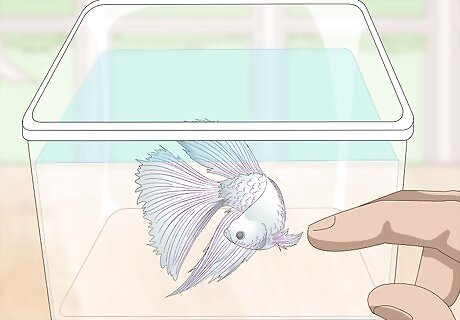
Examine the fins. Many people want to selectively breed their bettas for fin size and finnage. Looking at the fins for characteristics you want to bring out as well as for potential injury can help ensure that you get the qualities you hope to breed. Check the caudal, or tail, fin for straightness and curvature. Good breeding stock bettas with have straighter caudal fins that are curved in opposite directions. Avoid bettas with caudal fins curved in the same direction. Look for ray branching or splitting on all of the bettas fins. The more branches or splits you have, the more supportive, larger, and beautiful finnage you will get. Make sure the betta has no traces of fin rot, which looks like ripped or fuzzy fins with red tips or near the tears.
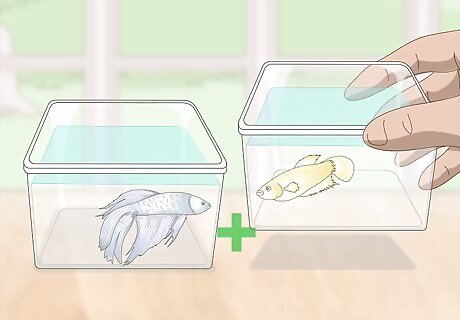
Combine complementary colors. Bettas come in and exhibit a wide range of colors on their bodies. Find the color bettas you like as mates or for your betta as a mate and try to choose colors that work well together. Be aware that bettas come in colors such as red, orange, yellow, turquoise, steel blue or royal blue. They can also have black or iridescent features. For example, you might find that breeding the blues with black lace features give your fish beautiful colors. Ask the breeder if you are unsure of what can work best for your betta.
Optimizing the Breeding Space

Have a large tank. You can breed your bettas in smaller tanks, but it's best for the fish to mate in a tank that is at least a 5-10 gallon. This ensures the delicate female has enough space and can make the mating process more optimal for both bettas. Remember that your bettas need separate tanks until it is time for them to breed. This keeps the fish from harming one another.
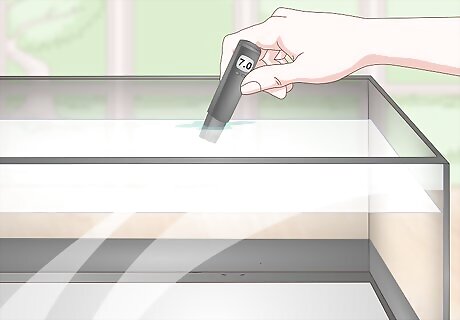
Ensure high water quality. Water quality is vital to the health and happiness of any betta. This is especially true during mating, so make sure that your tank water is as fresh and high quality as possible. Test the fish tank water with a test kit you can buy at most pet stores. Use the test to find potential problems with water quality, such as high ammonia, acidity or low pH, or low oxygen. Fix any problems in the water. The pH level should be about 7. If it isn't, get a chemical neutralizer at your local pet store to restore the levels back to 7. Oxygen saturation should exceed 70%. If it doesn't you may need to clean out the tank and fill it with new water or replace the charcoal filter. Make sure the water temperature it is between 50 and 78 degrees Fahrenheit with a thermometer. This can help promote breeding between your bettas and ensure quality spawn.
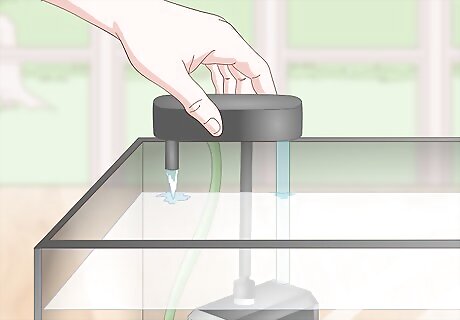
Use a gentle water filter. Bettas produce a lot of waste, which can effect water quality. Filter the water gently, which can maintain the health of your mating bettas, promote the mating process and help the eggs and fry survive. Watch for too much movement of the water by the filter. The natural habitat of bettas is still water, and anything that moves particularly roughly water may disturb bettas and their offspring.
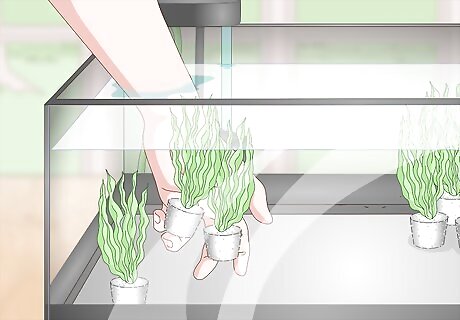
Provide hiding spots for females. Mating causes female bettas stress and can injure them. Hiding spots made out of plants can soothe the female and guard the bubble nest of eggs. Arrange an array of floating plants in the tank to optimize your bettas' breeding space. You can use live or artificial plants in the tank, all of which are available at pet stores or specialty fish retailers.
Mating Your Bettas
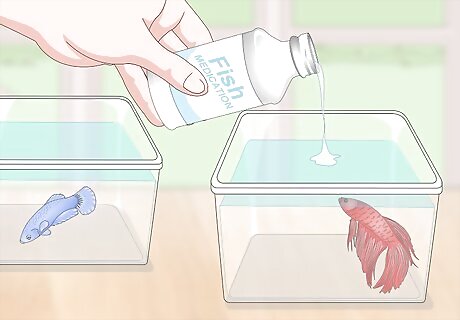
Check for health problems. If either betta is showing signs of illness, consider giving it commercial fish medication. This can treat your fish for diseases or parasites and aid breeding.
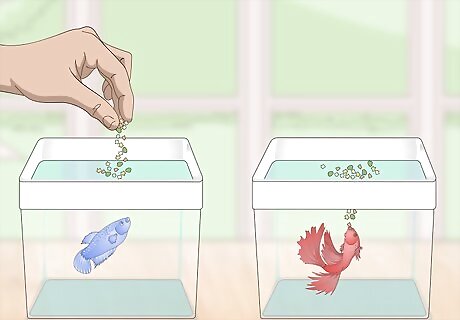
Feed your bettas. Breeding can stress and fatigue your betta pair. Feed them a hearty diet before they start breeding to optimize the process and ensure the health of the eggs and fry. Give the pair a mixture of live brine shrimp and flake food. Feed them once per day to prevent excess food from spoiling the water.
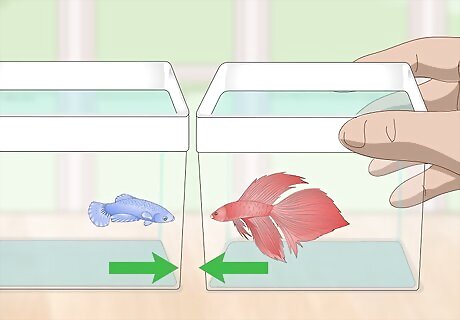
Introduce the betta mates. Once you have checked the health of and fed each betta, it's time for them to “meet.” Keep the bettas in separate tanks for a few days to help the pair acquaint themselves, prevent injury, and ensure higher quality eggs. Place the male and female in separate tanks close to one another for a day or two. You may notice the bettas showing interest in one another during this time, which is a sign they're ready to mate.
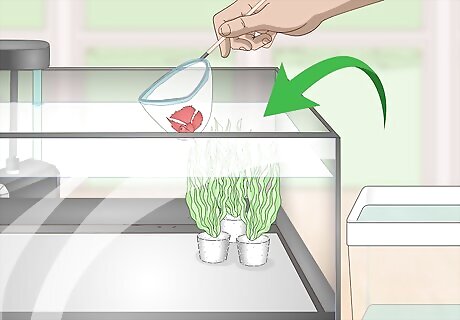
Place the male in the breeding tank. Move the male to the breeding tank once the bettas have had a chance to get acquainted in separate tanks. Keep the female in her tank for a few hours so that the male can prepare himself to breed. Check that the male isn't exhibiting any signs of distress before adding the female to the water. Bettas show stress by banging their bodies up against the sides of the tank or swimming near the surface.
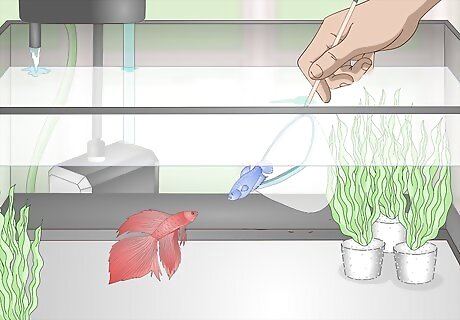
Put the female betta in the breeding tank. Once the male is safely in the breeding tank for a few hours, you can slowly introduce the female to the tank. Giving her an initial separate space within the tank helps her acclimate and can prevent the male from stressing her before she is ready. Protect the female in the breeding tank with a hurricane glass or cut a Styrofoam cup in half. Gently lower this separate container into the tank and place it up against one of the tank walls. Avoid sealing the glass or cup flush against the wall, which can prevent her from swimming out to the male to breed. Give her enough space by which she can easily swim out. Make sure the male can see the female's container, which may stimulate him to start building a bubble nest.
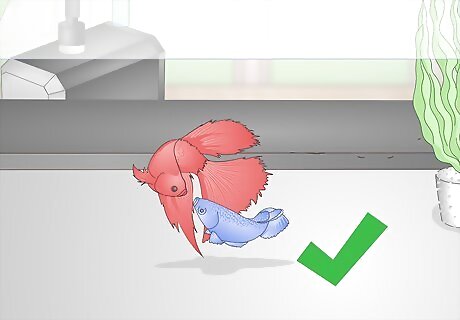
Detect attraction between the bettas. Observe the bettas to discern if there is any interest between the pair such as fin fanning. This can not only help you figure out if the bettas need new mates, but also if the female is ready to release her eggs. Watch for flaring or fanning of the fins, which is a good sign of interest between the mating pair of bettas. Be aware that it can take 4-5 for bettas to show interest in their mate.
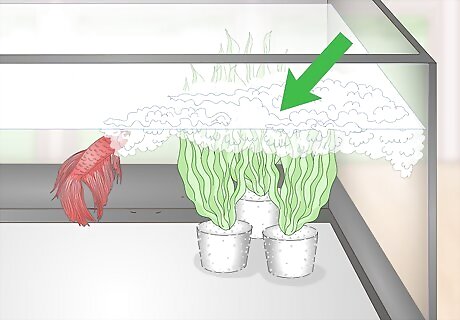
Recognize the bubble nest. If your bettas show interest in one another, you may see the male create a bubble nest. This is a sign to release the female her separate enclosure within the breeding tank. Be aware that the male may release his bubble nest on the hurricane glass or Styrofoam cup and the female may lay her eggs before she is released from the hurricane glass or Styrofoam cup. This is normal and not a cause for worry.
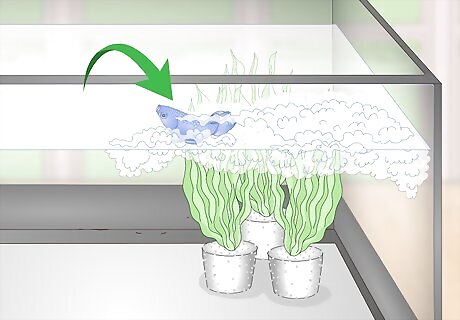
Lay the female on the bubble nest. When your male betta creates his bubble nest, he may also try and attract the female with fin flaring. If she doesn't move from her spot, put the female on top of the bubble nest to make sure she lays her eggs within the protective bubbles. Check to make sure the female is ready to release eggs. This is evident when she has vertical stripes on each side of her body. Place the female on or near the bubble nest so she can lay eggs even if she released some eggs in her container.
Hatching the Eggs
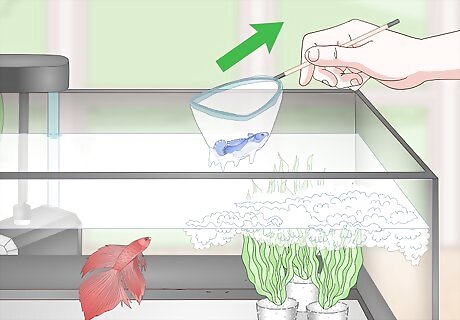
Take the female out of the tank. Once she's laid her eggs, remove the female from the breeding tank. Put her back in her usual tank, which can prevent injury to her from the very devoted male betta. Be aware that a female may lie still for a few moments after laying her eggs. Male bettas may also chase females away from the bubble nest when they're done laying eggs. Put the female in her old tank or consider letting her rest for a few days in a hospital or holding tank.
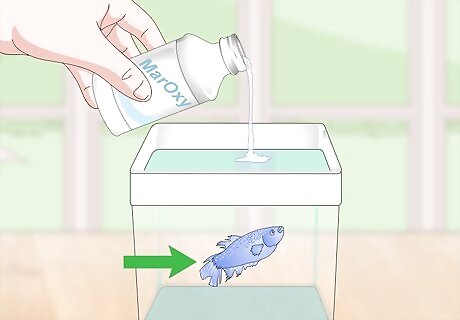
Treat wounds. Bettas are easily injured in the mating process. Check for torn fins after they mate to prevent disease or death. Add a commercial water treatment such as MarOxy or Bettamax to prevent disease in recently bred bettas. Buy the water treatments at a pet stores or a specialty fish supplier. Separate the fish if you notice significant stress or wounding.
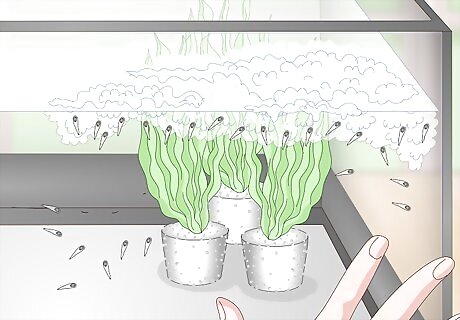
See eggs develop into fry. After about three days, check to see if the eggs have hatched. The fry, which have the appearance of little black dots, will also have little tails. Watching for the development of fry signals you to remove the male betta, which can maintain the safety and health of the fry. Put the male back in his tank or a hospital tank for a few days. Feed the fry once they're swimming freely. Fry get “infusoria,” which is easily made by placing a lightly boiled potato in a jar of aquarium water for 2 days to culture the microscopic animals. Put some of the infusoria water in the tank with the fry 2 times a day. Allow the fry to stay together for about 7 months. If you wait longer, they may start to fight and injure one another and flaring with one another.
Inbreeding for Selectivity
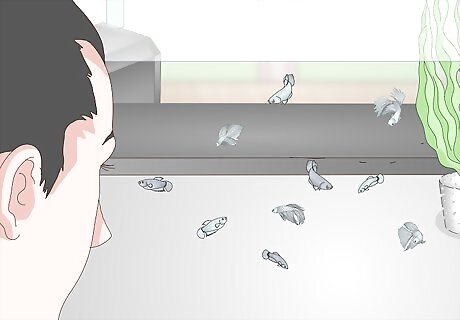
Look over the spawn. If you want to breed bettas that recently hatched, choose the best male and female from the spawn to continue breeding once the bettas are old enough. Consider selling the rest of the bettas, though you may want to keep the second best male and second best female as back up in case one pair doesn't work. Keep track of the parentage of each new group as well as which bettas you plan to breed based on the traits you want to enhance. Remember that by taking the best spawn from each generation of breeding, that you are one step closer to bringing out your chosen traits.
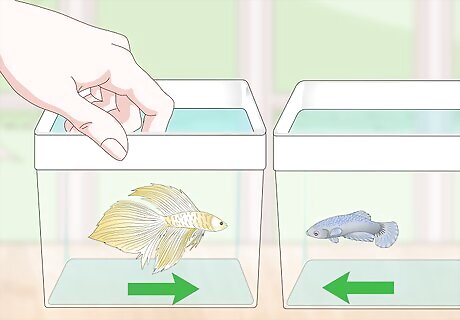
Introduce new genes. Although you should inbreed as much as possible to get the traits you want, you will eventually need to start the process over again and introduce new genes. Purchase a new male or female betta that look similar to your line. Breed the individual with your fish and then continue to inbreed the new fry. Get your new betta from a reputable breeder. Consider swapping your young betta for one of theirs as a form of payment. This can be beneficial to you and the other breeder.
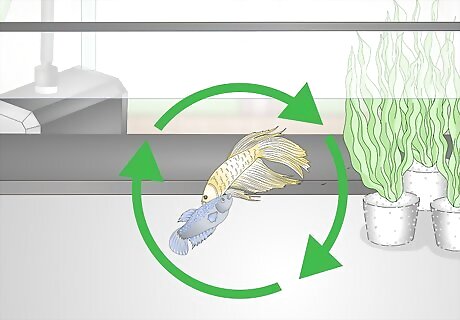
Repeat the process. Inbreed bettas for six generations before introducing new genes. This can help bring out great coloring and finnage on your bettas' generational lines. Be aware that it can take years of breeding to get the exact color or finnage you want from your bettas. Remember to be patient and keep breeding.




















Comments
0 comment